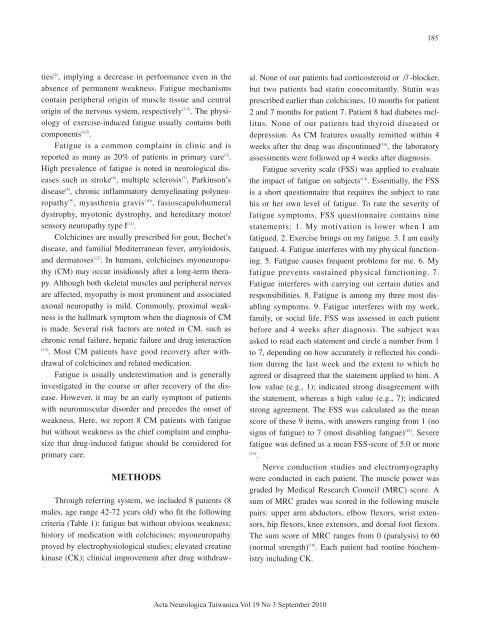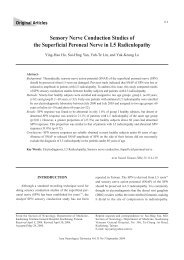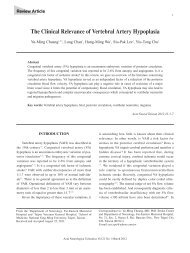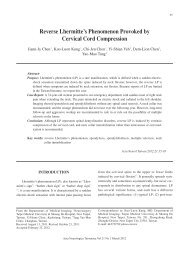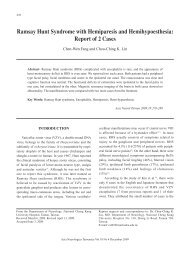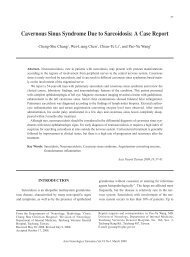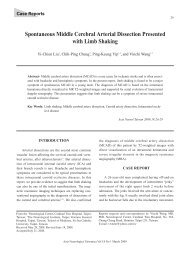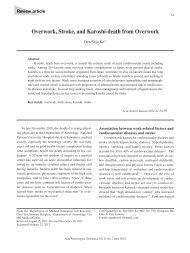Fatigue as the Only Clinical Manifestation of ... - ResearchGate
Fatigue as the Only Clinical Manifestation of ... - ResearchGate
Fatigue as the Only Clinical Manifestation of ... - ResearchGate
Create successful ePaper yourself
Turn your PDF publications into a flip-book with our unique Google optimized e-Paper software.
185<br />
ties (2) , implying a decre<strong>as</strong>e in performance even in <strong>the</strong><br />
absence <strong>of</strong> permanent weakness. <strong>Fatigue</strong> mechanisms<br />
contain peripheral origin <strong>of</strong> muscle tissue and central<br />
origin <strong>of</strong> <strong>the</strong> nervous system, respectively (3-5) . The physiology<br />
<strong>of</strong> exercise-induced fatigue usually contains both<br />
components (4,5) .<br />
<strong>Fatigue</strong> is a common complaint in clinic and is<br />
reported <strong>as</strong> many <strong>as</strong> 20% <strong>of</strong> patients in primary care (2) .<br />
High prevalence <strong>of</strong> fatigue is noted in neurological dise<strong>as</strong>es<br />
such <strong>as</strong> stroke (6) , multiple sclerosis (7) , Parkinson’s<br />
dise<strong>as</strong>e (8) , chronic inflammatory demyelinating polyneuropathy<br />
(9) , my<strong>as</strong><strong>the</strong>nia gravis (10) , f<strong>as</strong>ioscapulohumeral<br />
dystrophy, myotonic dystrophy, and hereditary motor/<br />
sensory neuropathy type I (11) .<br />
Colchicines are usually prescribed for gout, Bechet’s<br />
dise<strong>as</strong>e, and familial Mediterranean fever, amyloidosis,<br />
and dermatoses (12) . In humans, colchicines myoneuropathy<br />
(CM) may occur insidiously after a long-term <strong>the</strong>rapy.<br />
Although both skeletal muscles and peripheral nerves<br />
are affected, myopathy is most prominent and <strong>as</strong>sociated<br />
axonal neuropathy is mild. Commonly, proximal weakness<br />
is <strong>the</strong> hallmark symptom when <strong>the</strong> diagnosis <strong>of</strong> CM<br />
is made. Several risk factors are noted in CM, such <strong>as</strong><br />
chronic renal failure, hepatic failure and drug interaction<br />
(13)<br />
. Most CM patients have good recovery after withdrawal<br />
<strong>of</strong> colchicines and related medication.<br />
<strong>Fatigue</strong> is usually underestimation and is generally<br />
investigated in <strong>the</strong> course or after recovery <strong>of</strong> <strong>the</strong> dise<strong>as</strong>e.<br />
However, it may be an early symptom <strong>of</strong> patients<br />
with neuromuscular disorder and precedes <strong>the</strong> onset <strong>of</strong><br />
weakness. Here, we report 8 CM patients with fatigue<br />
but without weakness <strong>as</strong> <strong>the</strong> chief complaint and emph<strong>as</strong>ize<br />
that drug-induced fatigue should be considered for<br />
primary care.<br />
METHODS<br />
Through referring system, we included 8 patients (8<br />
males, age range 42-72 years old) who fit <strong>the</strong> following<br />
criteria (Table 1): fatigue but without obvious weakness;<br />
history <strong>of</strong> medication with colchicines; myoneuropathy<br />
proved by electrophysiological studies; elevated creatine<br />
kin<strong>as</strong>e (CK); clinical improvement after drug withdrawal.<br />
None <strong>of</strong> our patients had corticosteroid or -blocker,<br />
but two patients had statin concomitantly. Statin w<strong>as</strong><br />
prescribed earlier than colchicines, 10 months for patient<br />
2 and 7 months for patient 7. Patient 8 had diabetes mellitus.<br />
None <strong>of</strong> our patients had thyroid dise<strong>as</strong>ed or<br />
depression. As CM features usually remitted within 4<br />
weeks after <strong>the</strong> drug w<strong>as</strong> discontinued (14) , <strong>the</strong> laboratory<br />
<strong>as</strong>sessments were followed up 4 weeks after diagnosis.<br />
<strong>Fatigue</strong> severity scale (FSS) w<strong>as</strong> applied to evaluate<br />
<strong>the</strong> impact <strong>of</strong> fatigue on subjects (14) . Essentially, <strong>the</strong> FSS<br />
is a short questionnaire that requires <strong>the</strong> subject to rate<br />
his or her own level <strong>of</strong> fatigue. To rate <strong>the</strong> severity <strong>of</strong><br />
fatigue symptoms, FSS questionnaire contains nine<br />
statements: 1. My motivation is lower when I am<br />
fatigued. 2. Exercise brings on my fatigue. 3. I am e<strong>as</strong>ily<br />
fatigued. 4. <strong>Fatigue</strong> interferes with my physical functioning.<br />
5. <strong>Fatigue</strong> causes frequent problems for me. 6. My<br />
fatigue prevents sustained physical functioning. 7.<br />
<strong>Fatigue</strong> interferes with carrying out certain duties and<br />
responsibilities. 8. <strong>Fatigue</strong> is among my three most disabling<br />
symptoms. 9. <strong>Fatigue</strong> interferes with my work,<br />
family, or social life. FSS w<strong>as</strong> <strong>as</strong>sessed in each patient<br />
before and 4 weeks after diagnosis. The subject w<strong>as</strong><br />
<strong>as</strong>ked to read each statement and circle a number from 1<br />
to 7, depending on how accurately it reflected his condition<br />
during <strong>the</strong> l<strong>as</strong>t week and <strong>the</strong> extent to which he<br />
agreed or disagreed that <strong>the</strong> statement applied to him. A<br />
low value (e.g., 1); indicated strong disagreement with<br />
<strong>the</strong> statement, where<strong>as</strong> a high value (e.g., 7); indicated<br />
strong agreement. The FSS w<strong>as</strong> calculated <strong>as</strong> <strong>the</strong> mean<br />
score <strong>of</strong> <strong>the</strong>se 9 items, with answers ranging from 1 (no<br />
signs <strong>of</strong> fatigue) to 7 (most disabling fatigue) (15) . Severe<br />
fatigue w<strong>as</strong> defined <strong>as</strong> a mean FSS-score <strong>of</strong> 5.0 or more<br />
(15)<br />
.<br />
Nerve conduction studies and electromyography<br />
were conducted in each patient. The muscle power w<strong>as</strong><br />
graded by Medical Research Council (MRC) score. A<br />
sum <strong>of</strong> MRC grades w<strong>as</strong> scored in <strong>the</strong> following muscle<br />
pairs: upper arm abductors, elbow flexors, wrist extensors,<br />
hip flexors, knee extensors, and dorsal foot flexors.<br />
The sum score <strong>of</strong> MRC ranges from 0 (paralysis) to 60<br />
(normal strength) (16) . Each patient had routine biochemistry<br />
including CK.<br />
Acta Neurologica Taiwanica Vol 19 No 3 September 2010


